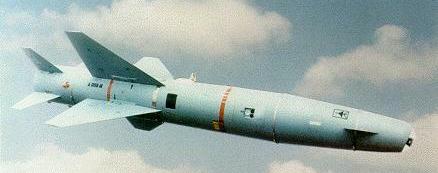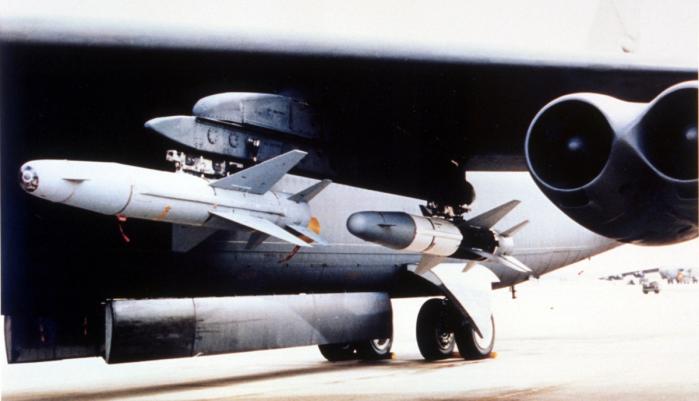Rafael/Lockheed Martin AGM-142 Popeye/Have Nap
The AGM-142 is the U.S. Air Force designation for the Israeli Popeye air-to-surface standoff missile. The missile is used by the USAF as a major enhancement of the B-52's conventional precision-attack capabilities.
In the late 1980s, the Israeli company Rafael Armament Development Authority developed the Popeye missile from its electro-optically (TV) guided Pyramid glide bomb. Like the latter, the Popeye has a TV seeker, whose image is used by the operator to acquire a target. The seeker logic can be locked on a selected target either before or, through the use of a two-way data link, after launch. Production of the missile began in 1989.
 |
| Photo: Rafael |
| Popeye (AGM-142A) |
In 1988, Popeye was selected by the USAF for the Have Nap program to improve the non-nuclear capabilities of the B-52G/H. The Air Force designated the missile as AGM-142A and assigned the name Raptor. However, the latter had to be dropped after the same name had been selected for the F-22 (now F/A-22) Advanced Technology Fighter, and the AGM-142 is now generally known by the program name Have Nap. The Have Nap became operational with the USAF in 1992. The missile is powered by a solid-fuel rocket motor in the WPU-14/B propulsion section. Its 340 kg (750 lb) blast-fragmentation warhead is triggered by a tail-mounted FMU-124C/B impact fuze. Accuracy is quoted to be around 3 m (10 ft) CEP. Unarmed training versions include the ATM-142A, the captive-carry CATM-142A and the DATM-142A for ground handling training.
The AGM-142B is a derivative of the AGM-142A which substitutes the TV seeker with an IIR (Imaging Infrared) seeker. The AGM-142C uses the TV seeker and a new 350 kg (770 lb) "I-800" penetrator warhead, and the AGM-142D is a variant with the AGM-142B's IIR seeker and the AGM-142C's penetrator warhead. For the unarmed training variants of the AGM-142, no distinction between warhead options is necessary. Therefore, the various ATM-142A versions are also used for AGM-142C training. The unarmed IIR missiles for AGM-142B/D training are designated ATM-142D, CATM-142D and DATM-142D.
 |
| Photo: Lockheed Martin |
| AGM-142A |
The only aircraft in the USAF, which currently employs the AGM-142 operationally, is the B-52H. A Have Nap-capable B-52H can carry two AGM-142s on one wing pylon, and a third missile and an AN/ASW-55 data link pod on the other one. The Have Nap was used in small numbers during Operation Enduring Freedom in Afghanistan. Because of the modular construction, the seeker (TV/IIR) and warhead (blast-fragmentation/penetrator) options can be configured at the USAF depots.
Beginning in 1993, a three-stage PEP (Producibility Enhancement Program) on the AGM-142 was conducted. The efforts included motor and airframes improvements for cheaper manufacture, new electronics hard- and software, and a new IMU (Inertial Measurement Unit). The final PEP stage (PEP III), which was tested in early 1998, introduced a new type of IIR seeker, generally referred to as "Z-seeker" (Z = Zoom).
The AGM-142E is a missile modified for export to Australia. It incorporates the PEP improvements, and is adapted for use with Australia's F-111C aircraft. It uses the Z-seeker and the AGM-142C/D's penetrating warhead. The ATM-142E, CATM-142E and DATM-142E are the training variants of the AGM-142E.
 |
| Photo: Lockheed Martin |
| AGM-142 (exact model unknown) |
The designation AGM-142F has been applied to missiles exported to Israel. The AGM-142F has clipped wings, and is equipped with the new Z-seeker and the "I-800" penetrator warhead of the AGM-142C/D. The AGM-142G is a variant for export to South Korea, equipped with the "I-800" warhead, a new CCD seeker, and software changes to make the missile compatible with the Korean Air Force's F-4E. The AGM-142H is also a South Korean version, identical to the AGM-142G except that it uses the Z-seeker.
New Popeye development and production is now managed by PGSUS (Precision Guided Systems United States), a joint-venture of Lockheed Martin (the U.S. prime contractor for the AGM-142 program) and Rafael. More than 500 AGM-142 missiles have been delivered to the USAF, but Have Nap will eventually be replaced in U.S. service by the AGM-158 JASSM.
There is a slightly shorter and lighter (4.27 m (14 ft), 1130 kg (2500 lb)) derivative of the Popeye known as Popeye 2 or Have Lite. It is intended for use with fighter-sized aircraft which cannot easily handle the heavier Have Nap. Although this variant is sometimes referred to as AGM-142B, the Popeye 2 has in fact not received any official U.S. missile designation.
Specifications
Note: Data given by several sources show slight variations. Figures given below may therefore be inaccurate!
Data for AGM-142A/B/C/D:
| Length | 4.83 m (15 ft 10 in) |
| Wingspan | 1.72 m (5 ft 8 in) |
| Diameter | 53.3 cm (21 in) |
| Weight | 1360 kg (3000 lb) |
| Speed | supersonic |
| Range | 80 km (50 miles) |
| Propulsion | Solid-fueled rocket |
| Warhead | AGM-142A/B: 340 kg (750 lb) blast-fragmentation AGM-142C/D: 350 kg (770 lb) "I-800" penetrator |
Main Sources
[1] Hajime Ozu: "Missile 2000 - Reference Guide to World Missile Systems", Shinkigensha, 2000
[2] John Pike: GlobalSecurity.org Website
[3] Department of Defense Missile Nomenclature Records
Back to Current Designations Of U.S. Unmanned Military Aerospace Vehicles
Back to Directory of U.S. Military Rockets and Missiles
Last Updated: 18 October 2002